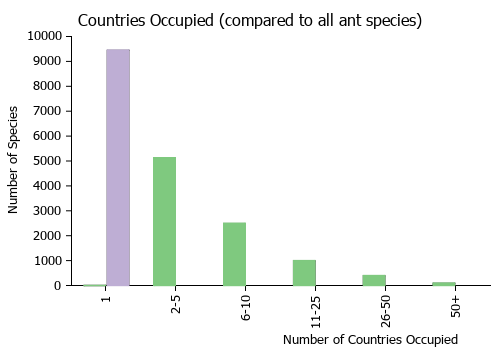Cryptopone arabica
| Cryptopone arabica | |
|---|---|
| Scientific classification | |
| Kingdom: | Animalia |
| Phylum: | Arthropoda |
| Class: | Insecta |
| Order: | Hymenoptera |
| Family: | Formicidae |
| Subfamily: | Ponerinae |
| Tribe: | Ponerini |
| Genus: | Cryptopone |
| Species: | C. arabica |
| Binomial name | |
| Cryptopone arabica Collingwood & Agosti, 1996 | |
Nothing is known about the biology of Cryptopone arabica.
Identification
Collingwood and Agosti (1996) - This species differs from the South European Cryptopone ochracea by the longer multidentate mandibles and overall larger body size.
Distribution
Latitudinal Distribution Pattern
Latitudinal Range: 15.184722° to 15.184722°.
| North Temperate |
North Subtropical |
Tropical | South Subtropical |
South Temperate |
- Source: AntMaps
Distribution based on Regional Taxon Lists
Afrotropical Region: Yemen (type locality).
Distribution based on AntMaps
Distribution based on AntWeb specimens
Check data from AntWeb
Countries Occupied
| Number of countries occupied by this species based on AntWiki Regional Taxon Lists. In general, fewer countries occupied indicates a narrower range, while more countries indicates a more widespread species. |

|
Estimated Abundance
| Relative abundance based on number of AntMaps records per species (this species within the purple bar). Fewer records (to the left) indicates a less abundant/encountered species while more records (to the right) indicates more abundant/encountered species. |

|
Biology
Castes
Nomenclature
The following information is derived from Barry Bolton's Online Catalogue of the Ants of the World.
- arabica. Cryptopone arabica Collingwood & Agosti, 1996: 310 (w.) YEMEN.
- Type-material: holotype worker, paratype workers (number not stated).
- Type-locality: holotype Yemen: Wadi Bani, 20.iii.1993 (C.A. Collingwood); paratypes with same data.
- Type-depository: unknown (perhaps WMLC).
- [Note: Collingwood & Agosti, 1996: 301, say “All type material is housed in NHMB and duplicates placed in appropriate institutes and museums of the contributing countries”; this apparently was never done.]
- Status as species: Borowiec, L. 2014: 69.
- Distribution: Yemen.
Unless otherwise noted the text for the remainder of this section is reported from the publication that includes the original description.
Description
Worker
Holotype: TL 3.2; HL 1.12; HW 1.02; SL 0.86; EL 0.11 (eyes with 12 ommatidia).
Head: long, almost straight-sided with the broadest part at the occiput which is incavate; eyes placed anteriorly well below the midline and visible in dorsal view; frontal furrow continued as a fine line to the occipital border; mandibles with a distinct dorsolateral pit, long and curved, with 12 denticles and a large apical tooth; length from apex to clypeal border 0.42, measured along outer moderately curved edge 0.60. Frontal laminae expanded laterally, concealing antennal insertions. Scapes broadening to apex, just reaching the occipital margin when laid back.
Alitrunk: metanotal suture well developed forming a clear break dorsally between mesonotum and propodeum; promesonotal suture also visible but not breaking dorsal outline of alitrunk. Petiole squamiform with a strongly developed ventral tooth. All tibiae with one large pectinate spur and one smaller simple spur about half the length of the other. Tarsal claws simple. Whole body including head and gaster covered in pale decumbent pubescence not obscuring the underlying dilute body sculpture so that the general appearance is shining. Four to five short suberect hairs are visible on each side of the head in dorsal view with two longer hairs at the lateral clypeal corners.
Type Material
Holotype: worker, Yemen, Wadi Bani, 20.III.1993, CA. Collingwood. - Paratypes: workers, same series as holotype.
References
- Borowiec, L. 2014. Catalogue of ants of Europe, the Mediterranean Basin and adjacent regions (Hymenoptera: Formicidae). Genus (Wroclaw) 25(1-2): 1-340.
- Collingwood, C. A. and D. Agosti. 1996. Formicidae (Insecta: Hymenoptera) of Saudi Arabia (part 2). Fauna Saudi Arabia. 15:300-385.
- Esteves, F.A., Fisher, B.L. 2021. Corrieopone nouragues gen. nov., sp. nov., a new Ponerinae from French Guiana (Hymenoptera, Formicidae). ZooKeys 1074, 83–173 (doi:10.3897/zookeys.1074.75551).
- Schmidt, C.A. & Shattuck, S.O. 2014. The higher classification of the ant subfamily Ponerinae (Hymenoptera: Formicidae), with a review of ponerine ecology and behavior. Zootaxa 3817, 1–242 (doi:10.11646/zootaxa.3817.1.1).